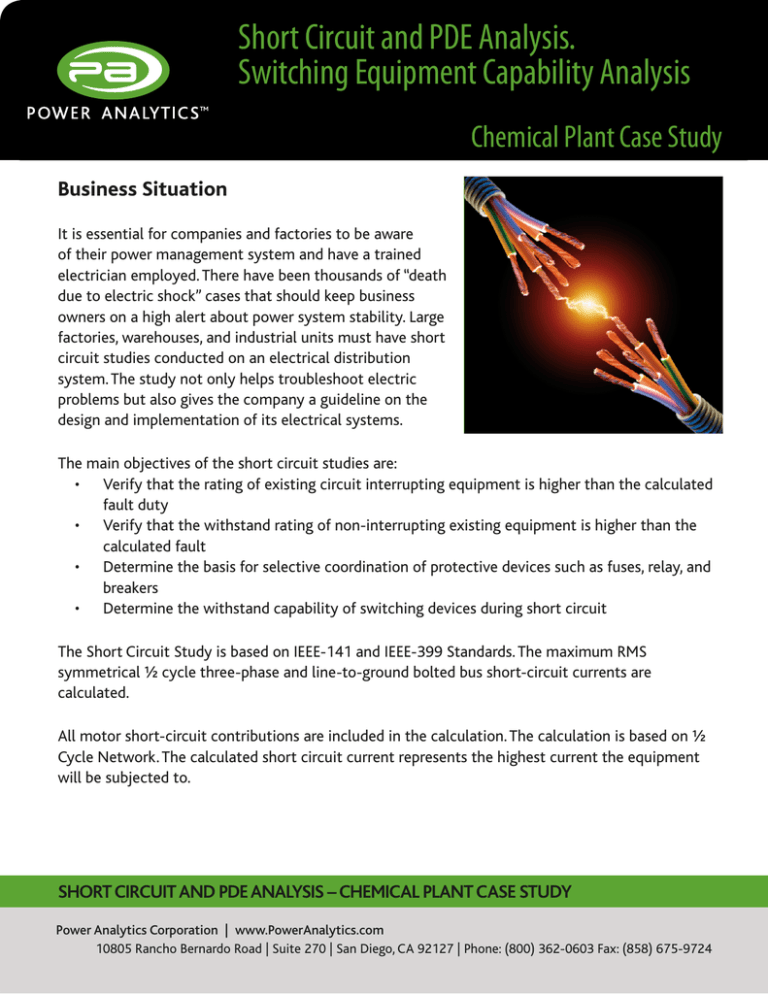
Short Circuit and PDE Analysis.
Switching Equipment Capability Analysis
Chemical Plant Case Study
Business Situation
It is essential for companies and factories to be aware
of their power management system and have a trained
electrician employed. There have been thousands of “death
due to electric shock” cases that should keep business
owners on a high alert about power system stability. Large
factories, warehouses, and industrial units must have short
circuit studies conducted on an electrical distribution
system. The study not only helps troubleshoot electric
problems but also gives the company a guideline on the
design and implementation of its electrical systems.
The main objectives of the short circuit studies are:
• Verify that the rating of existing circuit interrupting equipment is higher than the calculated
fault duty
• Verify that the withstand rating of non-interrupting existing equipment is higher than the
calculated fault
• Determine the basis for selective coordination of protective devices such as fuses, relay, and
breakers
• Determine the withstand capability of switching devices during short circuit
The Short Circuit Study is based on IEEE-141 and IEEE-399 Standards. The maximum RMS
symmetrical ½ cycle three-phase and line-to-ground bolted bus short-circuit currents are
calculated.
All motor short-circuit contributions are included in the calculation. The calculation is based on ½
Cycle Network. The calculated short circuit current represents the highest current the equipment
will be subjected to.
Short Circuit and PDE Analysis – Chemical Plant Case Study
Power Analytics Corporation | www.PowerAnalytics.com
10805 Rancho Bernardo Road | Suite 270 | San Diego, CA 92127 | Phone: (800) 362-0603 Fax: (858) 675-9724
Technical Situation
A Case Study is provided where DesignBase tools have been used for assisting the design of a
2.4/0.480 kV substation interconnected to the existing Chemical Plant power system. However,
the substation is part of a large Chemical Plant, and the system study was completed to determine
the Bus Voltage Profile, Branch Loading, and Short Circuit Level in the plant system network and
evaluate the switching and protective devices. Paladin DesignBase 4.0 software release was used to
complete the project. This presentation focuses on Short Circuit and Protective Devices Evaluation.
The study has been completed for a Chemical Plant to determine the Bus Voltage profile, branch
loading, and short circuit level in the network and evaluate the switching and protective devices for
the 2.4 kV and 0.48 kV Substation.
Solution
Paladin DesignBase software was used to perform the Short Circuit and PDE analysis. Once the
electrical system components were identified and laid out as a network, various study aspects were
completed and described in detail below.
Paladin DesignBase 4.0 is state-of-the-art computer aided design and simulation software
providing real solutions to any power system application. Based on the provided drawings and
system data from the client, the Paladin DesignBase plant model has been generated. The electrical
system extension of the Chemical Plant has been modeled as two separate models electrically
interconnected to the existing plant system model.
Bus IDs, branch names, and equipment characteristics are shown on the DesignBase model drawing
and project database. Equipment Naming has been input as per “One line diagrams provided by the
client.” However, on completing this model the plant drawings and data from plant engineers were
employed.
Short Circuit and PDE Analysis – Chemical Plant Case Study
PAGE 2
Power Analytics Corporation | www.PowerAnalytics.com
10805 Rancho Bernardo Road | Suite 270 | San Diego, CA 92127 | Phone: (800) 362-0603 Fax: (858) 675-9724
System Configuration and Scenarios
The following configuration was considered in short circuit calculation (as per plant engineer
recommendations):
• Generators are ON
• Both utility lines are ON
• Available utility fault current is obtained from the model provided by the client
• All HV and MV CBs are closed
• All 2.4 kV breakers are closed
• All 480 breakers are closed, except the tie breakers that are normally open. The exceptions to
the above are the breakers that are clearly marked in the model as future, out of service, or
for spare circuits, etc.
• All motors are running
• Tie breakers of all double-ended substations are open
Having a close communication with the client, 4 scenarios were implemented:
• Both 2.4 kV and 0.48 kV tie CBs open
• The 2.4 kV tie CB closed and 0.48 kV tie CB open
• Both 2.4 kV and 0.48 kV tie CBs closed
• The 2.4 kV tie CB open and 0.48 kV tie CB closed
Short Circuit and PDE Analysis – Chemical Plant Case Study
PAGE 3
Power Analytics Corporation | www.PowerAnalytics.com
10805 Rancho Bernardo Road | Suite 270 | San Diego, CA 92127 | Phone: (800) 362-0603 Fax: (858) 675-9724
Assumptions:
In modeling the plant power system and performing the studies, the following assumptions were
made:
• The impedance of protective devices is as per DesignBase Standard Library
• Motors data are as per data provided by the client or as per DesignBase library
• Feeder data are as per data provided by the client or as per DesignBase feeder library
The short circuit results were provided and shown in 12 Appendices that are a part of the project.
The summary of the results for the major buses in the system is shown below. Scenario 3 is the
worst scenario: both 2.4 kV and 0.48 kV tie CBs are closed.
Tabulated Report 3 Phase and L-G bus fault current:
2.4 kV Substation:
Conclusions – Short Circuit Analysis:
All the MV CBs in the 2.4 kV Substation were rated 41 KA. However, if the 2.4 kV Tie CB is closed, all
the MV CBs cannot withstand during the short circuit.
Short Circuit and PDE Analysis – Chemical Plant Case Study
PAGE 4
Power Analytics Corporation | www.PowerAnalytics.com
10805 Rancho Bernardo Road | Suite 270 | San Diego, CA 92127 | Phone: (800) 362-0603 Fax: (858) 675-9724
Protective Device Evaluation:
Protective Device Evaluation was performed for all switching devices: HV, MV, and LV circuit
breakers, switches, and fuses. One needs to highlight that where no information was available for
interrupting time cycle for HV and MV breakers, and closing and latching current, the HV and MV
breakers interrupting time was considered 5 cycles, and for asymmetrical closing and latching one
has considered 1.6 x Max. interrupting current; for closing and latching peak was considered 2 x
asymmetrical closing/latching current. These are as per IEEE standards and rules. Duty type for PDE
was considered the total bus fault current. This is the most severe and conservative option. The PDE
results were provided in several Appendices together with PDE visualization for easier identification.
Benefits
Worst Scenario in PDE: Scenario 2
For this application, two distinct benefits were realized, the protective device coordination and the
arc flash area. The PDC benefits include:
• Avoid catastrophic losses
• Increase the safety and reliability of the power system and related equipment
• Evaluate the application of protective devices and equipment
• Identify areas for improvement in the electrical system
Short Circuit and PDE Analysis – Chemical Plant Case Study
PAGE 5
Power Analytics Corporation | www.PowerAnalytics.com
10805 Rancho Bernardo Road | Suite 270 | San Diego, CA 92127 | Phone: (800) 362-0603 Fax: (858) 675-9724
Products and Services Your Company Used
Power Analytics’ Short Circuit Analysis program delivers a first-of-a-kind solution to allow power
system specialists to calculate the short circuit current based on IEEE or IEC standards. The Short
Circuit Analysis program has integrated Power Analytics’ Protective Device Evaluation (PDE) program
for checking the interrupting capabilities of the switching devices, such as CBs, fuses, and switches.
Power Analytics’ Short Circuit Analysis program is a very powerful and proven tool for electrical
engineers, having been proven in demanding, real-world applications and in rigorous software
testing based on long hand calculation.
Both three-phase and single-phase networks can be modeled, and any type of fault can be
simulated: 3P, L-L, L-L-G, L-G. Only Power Analytics’ Short Circuit Analysis program calculates sliding
faults, an important feature for impedance protection operation or for calculating the L-G faults
needed for towers grounding.
Power Analytics Short Circuit Analysis Program, ANSI/EEE/IEC
•
•
•
•
•
•
•
•
•
•
•
•
•
•
•
Unlimited bus simulation (50,000+)
IEEE and IEC standards
Three-phase and single-phase network on the same model
All types of faults: 3P, L-L, L-L-G, L-G: solid faults or via a fault impedance
Integrated Protective Device Evaluation (PDE) program
Short circuit current calculation inside MCC schedule
Considering the lines mutual couplings
Sliding faults and series faults
Program fully integrated with electrical one-line diagram
Flexible selection of faulted bus, directly on the one line diagram or text driven selection
User-defined groups of faulted buses
Fault at all buses or selected buses – user defined
Online back annotation or customized text output report
Easy-to-use and results are at a glance as per user selection
Comprehensive monitoring of the bus short circuit results
Short Circuit and PDE Analysis – Chemical Plant Case Study
PAGE 6
Power Analytics Corporation | www.PowerAnalytics.com
10805 Rancho Bernardo Road | Suite 270 | San Diego, CA 92127 | Phone: (800) 362-0603 Fax: (858) 675-9724
About Power Analytics Corporation
Used by the power industry for more than 25 years, Power Analytics’ software solutions have surged
to the forefront of the electrical system planning, operation, and smart grid market space for use in
energy intensive, mission-critical facilities and microgrids. Paladin products currently protect more
than $100 billion in customer assets including financial data centers, air traffic control sites, military
installations, deep sea oil platforms, and power generation and distribution facilities. The company is
headquartered in San Diego, Calif., and has a smart grid center of excellence in Raleigh, N.C.
© Copyright 2013 Power Analytics Corporation. All rights reserved. Paladin, Power Analytics, Paladin
DesignBase, Paladin Live, Paladin SmartGrid, Paladin SmartGrid Power Management System, Paladin
Gateway, Paladin DesignView, Intelligence in Real Time, and Foresight as Accurate as Hindsight
and their associated logos and stylings, are pending or registered trademarks of Power Analytics
Corporation. All other trademarks, names, and logos are the property of their respective holders.
Power Analytics gratefully acknowledges governmental and regulatory agencies whose names,
photos, logos, award programs, or certification programs are listed herein; such use does not
constitute their endorsement of Power Analytics or its products by these agencies.
For more information about Power Analytics’ Paladin Software, visit www.PowerAnalytics.com.
Short Circuit and PDE Analysis – Chemical Plant Case Study
PAGE 7
Power Analytics Corporation | www.PowerAnalytics.com
10805 Rancho Bernardo Road | Suite 270 | San Diego, CA 92127 | Phone: (800) 362-0603 Fax: (858) 675-9724



